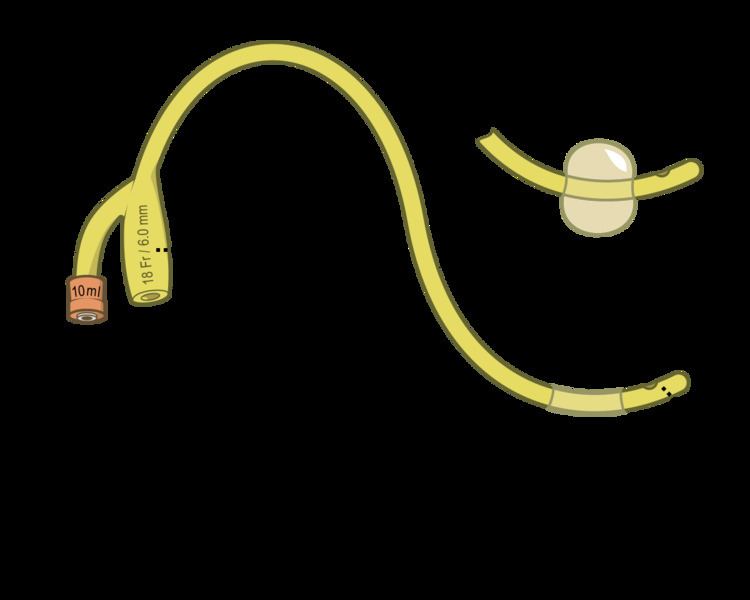 | ||
A Foley catheter (named for its designer, Frederic Foley) is a flexible tube that is passed through the urethra and into the bladder to drain urine. It is the most common type of indwelling urinary catheter.
Contents
- In the urinary tract
- Cervical
- Other
- Contraindications
- Adverse effects
- History
- Manufactured types
- References
The tube of a Foley catheter has two separated channels, or lumens, running down its length. One lumen is open at both ends, and drains urine into a collection bag. The other lumen has a valve on the outside end and connects to a balloon at the tip. The balloon is inflated with sterile water when it lies inside the bladder to stop it from slipping out. Foley catheters are commonly made from silicone rubber or natural rubber.
Foley catheters should be used only when indicated, as use increases the risk of catheter-associated urinary tract infection and other adverse effects.
In the urinary tract
In an emergency department, indwelling urinary catheters are most commonly used to assist persons who cannot urinate. Indications for using a catheter include providing relief when there is urinary retention, monitoring urine output for critically ill persons, managing urination during surgery, and providing end-of-life care.
Foley catheters are used during the following situations:
Cervical
A Foley catheter can also be used to ripen the cervix during induction of labor. When used for this purpose, the procedure is called extra-amniotic saline infusion (EASI). In this procedure, the balloon is inserted behind the cervical wall and inflated, such for example with 30 mL per hour. The remaining length of the catheter is pulled slightly taut, and taped to the inside of the woman's leg. The inflated balloon applies pressure to the cervix, as the baby's head would prior to labour, causing it to dilate. As the cervix dilates over time, the catheter is readjusted to again be slightly taut, and re-taped to maintain pressure on the cervix. When the cervix has dilated sufficiently, the catheter simply drops out.
Other
They are also used in cases of severe epistaxis (nosebleed), to block blood from freely flowing down the nasal passage into the mouth.
Contraindications
Indwelling urinary catheters should not be used to monitor stable people who are able to urinate or for the convenience of the patient or hospital staff.
In the United States, catheter-associated urinary tract infection is the most common type of hospital-acquired infection. Indwelling catheters should be avoided when there are alternatives, and when patients and caregivers discuss alternatives to indwelling urinary catheters with their physicians and nurses then sometimes an alternative may be found. Emergency physicians can reduce their use of indwelling urinary catheters when they follow evidence-based guidelines for usage, such as those published by the Centers for Disease Control and Prevention.
Adverse effects
A major problem with Foley catheters is that they tend to contribute to urinary tract infections (UTI). This occurs because bacteria can travel up the catheter to the bladder, where the urine can become infected. To combat this, the industry is moving to antiseptic coated catheters. This has been helpful, but has not completely solved this major problem. An additional problem is that Foley catheters tend to become coated over time with a biofilm that can obstruct the drainage. This increases the amount of stagnant urine left in the bladder, which further contributes to the problem of urinary tract infections. When a Foley catheter becomes clogged, it must be flushed or replaced.
There are several risks in using a Foley catheter (or catheters generally), including:
History
The name comes from the designer, Frederic Foley, a surgeon who worked in Boston, Massachusetts in the 1930s. His original design was adopted by C. R. Bard, Inc. of Murray Hill, New Jersey, who manufactured the first prototypes and named them in honor of the surgeon.
Manufactured types
The relative size of a Foley catheter is described using French units (F). The most common sizes are 10 F to 28 F. 1 F is equivalent to 0.33 mm = .013" = 1/77" of diameter.
Foley catheters come in several types:
